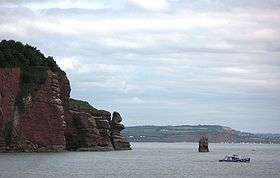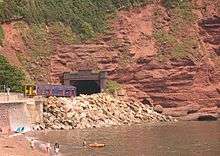Legend of the Parson and Clerk

The legend of the Parson and Clerk is a tale focusing on a clergyman and the devil set near two stacks located near the towns of Teignmouth and Dawlish, Devon, England. Along the coast towards Dawlish where the railway runs through the Parson's tunnel can be seen the twin stacks of the Parson and Clerk.
Geology

The Parson and Clerk are composed of relatively friable sedimentary Teignmouth Breccia of Permian age, as are all the nearby cliffs. Their soft rock layers are preserved from erosion by the harder "caprock" that was deposited above their strata[1] A further outer rock, Shag Rock, lost most of its height in a storm in 1984, and then lost its "head" in a storm in January 2003.[2]
The Parson and Clerk and the cliffs are easily viewed from the South West Coast Path which follows the Exeter to Newton Abbot railway line along the coast between Parson's Tunnel and Teignmouth.
Legend
Many versions of the story exist. Robert Hunt (in 1881)[3] and Sarah Hewett (1900)[4] relates that a certain Bishop of Exeter fell ill and came to Dawlish to restore his health. However, an ambitious local priest aimed to succeed to the See in the event of his superior's demise.
The priest's guide was his clerk, and they often made the journey to check on the condition of the bishop. One night, in a terrible storm, whilst crossing Haldon moor they lost their way and found themselves miles from the correct path. The priest in his frustration abused his clerk with the words I would rather have the devil himself, than you, for a guide. At that moment a horseman rode by and volunteered to be their guide.
After a few miles they came across a brilliantly lit mansion and were invited by their guide to enter and partake of his hospitality. They enjoyed a sumptuous repast and in the midst of the merriment the news arrived that the bishop was dead. Eager to secure his chance for promotion the priest prepared to leave, together with the clerk and the guide; however the horses refused to move. After liberal use of his whip and spurs the priest cried Devil take the brutes, upon which the guide exclaimed Thank you, sir and shouted Gee up. The horses galloped over the cliff, carrying the parson and the clerk with them. The devil turned them both to stone, facing forever seaward, monuments to greed and disappointed ambition.[4]
Origin
The story appears in 1848 in the anonymously-written Legends of Devon collection.[5] A correspondent to Notes and Queries in 1868 said that all the stories in the collection were original fiction without basis in folklore.
"The legends in question were severally composed by members of a very agreeable little private society, some thirty years ago, of whom I was one. The lady who collected and printed them, and was also one of the contributors, is dead, and so are some of her associates; and to give the names (even if I had permission), would interest few now. But I can say pretty confidently from memory, that they were each and all original whims of the moment, and not reproductions of popular legends.[6]
See also
References
- ↑ Selwood, E. B.; others (1984). Geology of the country around Newton Abbot. London: HMSO. p. 103. ISBN 0-11-884274-9.
- ↑ "Rocks that inspired legend to vanish?" Western Morning News (Plymouth, England), 22 January 2003
- ↑ Hunt, Robert, ed. (1993) [1881]. The Drolls, Traditions, and Superstitions of Old Cornwall. Felin Fach: Llanerch Publishers. ISBN 1-897853-17-3.
- 1 2 Hewett, Sarah (1900). Nummits and Crummits. Devonshire Customs, Characteristics and Folk-lore. Thomas Burleigh. pp. 177–179.
- ↑ Legends of Devon, 1848, London: Whittaker and Company, Exeter: Holden - Wallis, Dawlish LA Westcott. Google Books
- ↑ 'Jean Le Trouveur', Notes and Queries, 4th S.II, page 614, December 26, 1868. Google Books